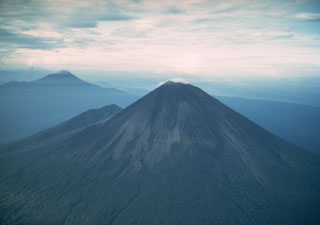Report on Ulawun (Papua New Guinea) — 31 July-6 August 2013
Smithsonian Institution / US Geological Survey
Weekly Volcanic Activity Report, 31 July-6 August 2013
Managing Editor: Sally Sennert.
Please cite this report as:
Global Volcanism Program, 2013. Report on Ulawun (Papua New Guinea) (Sennert, S, ed.). Weekly Volcanic Activity Report, 31 July-6 August 2013. Smithsonian Institution and US Geological Survey.
Ulawun
Papua New Guinea
5.05°S, 151.33°E; summit elev. 2334 m
All times are local (unless otherwise noted)
RVO reported that activity at Ulawun was low during 22 July-4 August; emissions from the summit crater consisted of white vapor. Seismicity was also low. RSAM values decreased from 80 on 21 July to 50 on 31 July, and then began to increase on early 2 August. By 4 August RSAM values reached 600, attributed to an increase in volcanic tremor.
Geological Summary. The symmetrical basaltic-to-andesitic Ulawun stratovolcano is the highest volcano of the Bismarck arc, and one of Papua New Guinea's most frequently active. The volcano, also known as the Father, rises above the N coast of the island of New Britain across a low saddle NE of Bamus volcano, the South Son. The upper 1,000 m is unvegetated. A prominent E-W escarpment on the south may be the result of large-scale slumping. Satellitic cones occupy the NW and E flanks. A steep-walled valley cuts the NW side, and a flank lava-flow complex lies to the south of this valley. Historical eruptions date back to the beginning of the 18th century. Twentieth-century eruptions were mildly explosive until 1967, but after 1970 several larger eruptions produced lava flows and basaltic pyroclastic flows, greatly modifying the summit crater.
Source: Rabaul Volcano Observatory (RVO)

